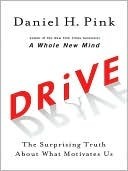More on this book
Community
Kindle Notes & Highlights
Read between
October 11 - October 19, 2022
this second drive came from without—the rewards and punishments the environment delivered for behaving in certain ways.
“The performance of the task,” he said, “provided intrinsic reward.”
“When money is used as an external reward for some activity, the subjects lose intrinsic interest for the activity,”
But the effect wears off—and, worse, can reduce a person’s longer-term motivation to continue the project.
should not concentrate on external-control systems such as monetary rewards,”
These new entities are purpose maximizers—which
An algorithmic task is one in which you follow a set of established instructions down a single pathway to one conclusion. That is, there’s an algorithm for solving it.
heuristic task is the opposite. Precisely because no algorithm exists for it, you have to experiment with possibilities and devise a novel solution.
that external rewards and punishments—both carrots and sticks—can work nicely for algorithmic tasks. But they can be devastating for heuristic ones.
The best use of money as a motivator is to pay people enough to take the issue of money off the table.
“People use rewards expecting to gain the benefit of increasing another person’s motivation and behavior, but in so doing, they often incur the unintentional and hidden cost of undermining that person’s intrinsic motivation toward the activity.”4
Rewarded subjects often have a harder time seeing the periphery and crafting original solutions.
It tainted
an altruistic act and “crowded out” the intrinsic desire to do something good.
that carrots and sticks can promote bad behavior, create addiction, and encourage short-term thinking at the expense of the long view.
Goals that people set for themselves and that are devoted to attaining mastery are usually healthy. But goals imposed by others—sales targets, quarterly returns, standardized test scores, and so on—can sometimes have dangerous side effects.
“Substantial evidence demonstrates that in addition to motivating constructive effort, goal setting can induce unethical behavior.”
The problem with making an extrinsic reward the only destination that matters is that some people will choose the quickest route there, even if it means taking the low road.
“Goals may cause systematic problems for organizations due to narrowed focus, unethical behavior, increased risk taking, decreased cooperation, and decreased intrinsic motivation. Use care when applying goals in your organization.”
“principal-agent theory.”
nucleus accumbens. That is, when the participants anticipated getting a reward (but not when they anticipated losing one), a burst of the brain chemical dopamine surged to this part of the brain. Knutson, who is now at Stanford University, has found similar results in subsequent studies where people anticipated rewards.
likelihood of individuals switching from risk-averse to risk-seeking behavior.”
“The very presence of goals may lead employees to focus myopically on short-term gains and to lose sight of the potential devastating long-term effects on the organization.”24
In environments where extrinsic rewards are most salient, many people work only to the point that triggers the reward—and
Is the task at hand routine? That is, does accomplishing it require following a prescribed set of rules to a specified end?
“even rudimentary cognitive skill,” a larger reward “led to poorer performance.”
You’ll likely get activity—but not much creativity.
Any extrinsic reward should be unexpected and offered only after the task is complete.
where “if-then” rewards are a mistake, shift to “now that” rewards—as
Praise and positive feedback are much less corrosive than cash and trophies.
“positive feedback can have an enhancing effect on intrinsic motivation.”
“self-determination theory (SDT).”
SDT, by contrast, begins with a notion of universal human needs. It argues that we have three innate psychological needs—competence, autonomy, and relatedness.
When people
aren’t producing, companies typically resort to rewards or punishment.
Human beings have an innate inner drive to be autonomous, self-determined, and connected to one another. And when that drive is liberated, people achieve more and live richer lives.
Type X behavior is fueled more by extrinsic desires than intrinsic ones. It concerns itself less with the inherent satisfaction of an activity and more with the external rewards to which that activity leads.
Type I’s almost always outperform Type X’s in the long run.
Think of Type X behavior as coal and Type I behavior as the sun.
Type I behavior depends on three nutrients: autonomy, mastery, and purpose.
ROWE—a results-only work environment.
In a ROWE workplace, people don’t have schedules. They show up when they want. They don’t have to be in the office at a certain time—or any time, for that matter. They just have to get their work done.
Deci and Ryan cite autonomy as one of three basic human needs. And of the three, it’s the most important—the sun around which SDT’s planets orbit. In the 1980s, as they progressed in their work, Deci and Ryan moved away from categorizing behavior as either extrinsically motivated or intrinsically motivated to categorizing it as either controlled or autonomous.
“Autonomous motivation involves behaving with a full sense of volition and choice,” they write, “whereas controlled motivation involves behaving with the experience of pressure and demand toward specific outcomes that comes from forces perceived to be external to the self.”1
Flexibility simply widens the fences and occasionally opens the gates. It, too, is little more than control in sheep’s clothing.
It calls for a renaissance of self-direction.
Type I behavior emerges when people have autonomy over the four T’s: their task, their time, their technique, and their team.
“homeshoring.”
It presumes
that people want to be accountable—and that making sure they have control over their task, their time, their technique, and their team is the most effective pathway to that destination.


